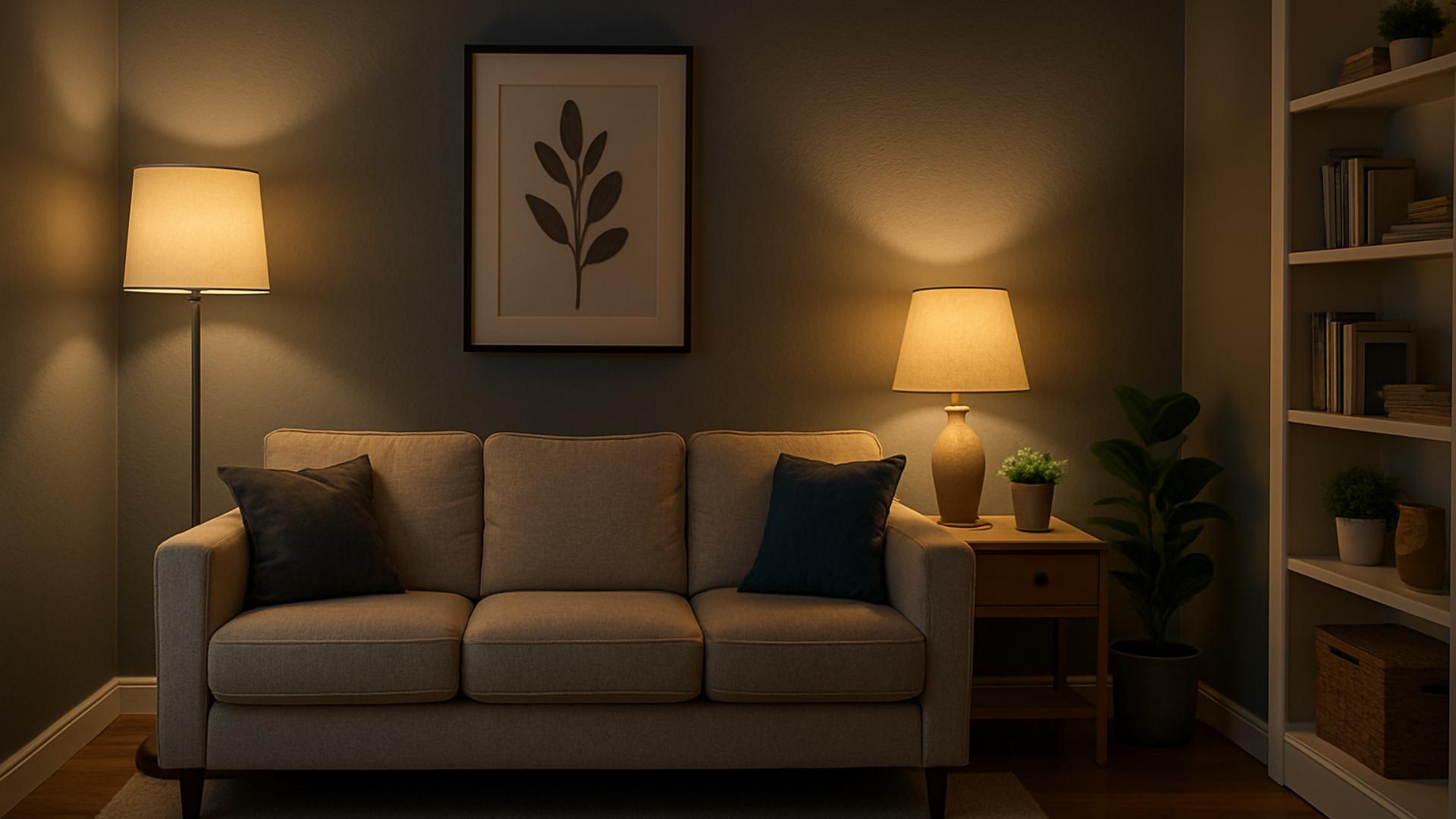When stepping into a room devoid of natural light, one might instinctively perceive a gloomy atmosphere. Yet, this apparent limitation can transform into a canvas for creativity. Welcome to the dynamic world of lighting design, where the absence of sunlight isn’t a hurdle but an opportunity to redefine your space. As I guide you through this journey, prepare to unlock the secrets to crafting a luminous environment that resonates with warmth and vitality.
Understanding the Dynamics of Light
Every room tells a story, and the way you illuminate it can set the mood, dictate the ambiance, and even influence the functionality of the space. The absence of natural light can be daunting, yet the right lighting strategy can turn any dark corner into the focal point of your home or office.
Breaking Down the Basics
Let’s start with the foundation: artificial lighting can be categorized into three primary types – ambient, task, and accent. Each serves a distinct purpose:
- Ambient Lighting: Often referred to as general lighting, it illuminates the entire room. Think ceiling lights, recessed lights, or even an oversized chandelier if you’re feeling bold.
- Task Lighting: Here, the focus is functionality. Whether you’re reading a book or crafting a masterpiece, task lighting ensures precision and clarity. Picture a sleek desk lamp or under-cabinet lighting in your kitchen.
- Accent Lighting: This is your artistic flair. Use it to highlight architectural features, art pieces, or décor elements. Wall sconces or LED strips hidden beneath shelves can work wonders.
Strategizing Your Lighting Layout
The key is to layer these different types. Combining ambient, task, and accent lighting creates depth and dimension, allowing the room to evolve throughout the day. While ambient lighting establishes the base, task and accent lights can be adjusted to suit the time and activity, granting flexibility and control.
Personal Touch
Remember, the goal is to create a personalized environment. Whether you prefer the soft glow of a vintage lamp or the crisp clarity of modern LED fixtures, your choices should reflect your personality and the room’s purpose.
Optimizing Color and Material Choices
Color isn’t just about aesthetics; it’s a strategic tool in your lighting arsenal. When used correctly, it has the power to alter perceptions, enhance moods, and transform your space into a sanctuary.
The Power of Whites and Light Colors
When dealing with a room that lacks natural light, leaning towards a bright color palette can make a significant difference. Whites and light colors reflect light, creating an illusion of a more open space. Consider painting walls in soft whites or pastels, which can amplify the effect of even the gentlest lamp.
Contrasts and Textures
Introducing texture through materials can add depth and intrigue, making a room feel more dynamic. Pair light walls with darker, textured furniture to create contrast. For instance, a plush, dark-colored sofa against light walls can become a striking centerpiece.
Dark Colors as Accents
Don’t shy away from using dark colors – consider them as accent pieces. Deep hues can define spaces, add drama, and enhance the coziness of a room. A midnight blue wall or charcoal accent pillows can provide a beautiful counterpoint to lighter elements.
Material Matters
The choice of materials can influence how light interacts with your space. Reflective surfaces, like glass and metal, can bounce light around, making the room appear brighter. Conversely, matte surfaces absorb light, so use them strategically to create balance.
Creating Cohesion
Ultimately, it’s about creating a cohesive look that aligns with your style. Allow the interplay of colors and materials to narrate your story, turning a light-deprived room into an inviting haven of warmth and personality. {image_content}
Harnessing the Power of Lamps and Fixtures
When natural light is a luxury you can’t afford, every lamp and light fixture becomes a vital ally in your quest for brightness. Exploring the world of lamps and fixtures is like entering a treasure trove, where each piece offers a unique way to enrich your space.
The Versatility of Lamps
Let’s start with lamps. Floor lamps, table lamps, and wall-mounted varieties each offer unique benefits. Floor lamps can serve as focal points and bring light to darker corners, while table lamps offer intimacy and style. Wall-mounted lamps free up valuable surface space and can add a touch of elegance.
Choosing the Right Bulbs
The bulb is as important as the fixture itself. Opt for LEDs where possible; they’re not only energy-efficient but also come in various color temperatures, allowing you to customize the ambiance. A warm white bulb can mimic the cozy glow of an evening sun, while a daylight bulb energizes the space.
Innovative Fixtures
Explore fixtures that offer adjustable settings. Dimmer switches provide versatility, enabling a seamless transition from bright task lighting to a softer, ambient glow. Consider track lighting or pendant lights for a more modern approach, giving your room a chic, updated feel.
The Importance of Placement
Strategic placement is key. Distribute fixtures evenly to eliminate dark zones and ensure a balanced light distribution. Experiment with angles, heights, and distances to find what works best for your space. The goal is to create layers of light that guide the eye and enhance the room’s architecture.
Enhancing with Decorative Elements
Incorporate decorative elements like artistic lampshades or statement pieces that double as light sources. These not only add character but also inject a sense of whimsy and creativity into your space.
Using Mirrors and Reflective Surfaces
Mirrors and reflective surfaces are secret weapons in the battle against darkness. When used strategically, they can double the effectiveness of your lighting efforts, making a room appear larger and more luminous.
The Magic of Mirrors
Mirrors are the unsung heroes of interior design. They have the unique ability to reflect light and give the illusion of more space. Position mirrors across from light sources to maximize their effect. A large mirror on one wall can bounce light throughout the room and add depth.
Reflective Décor
Introducing reflective materials, such as glass, polished metals, and high-gloss finishes, can amplify the light. Consider glass-topped tables, metallic frames, or glossy tiles. These elements lend a sophisticated touch and ensure your space feels airy and vibrant.
Mirrors as Focal Points
Use mirrors not just functionally but also decoratively. A statement mirror can become a striking focal point, drawing the eye and adding a layer of elegance. Opt for interesting shapes or ornate frames to make an impact.
Balancing Functionality and Aesthetics
While mirrors and reflective surfaces are excellent tools, balance is key. Too many reflective elements can create a disorienting space. Aim for harmony, allowing these features to complement rather than overwhelm your design.
Tailored to Your Style
Mirrors and reflections should align with your personal style. Whether you prefer vintage elegance or modern minimalism, the reflective elements you choose should enhance your overall aesthetic, creating a room that’s uniquely yours.
Creating a beautifully lit space without natural light is akin to composing a symphony, where each element plays its part in harmony. Through thoughtful selection of colors, textures, lamps, and mirrors, I hope to have inspired you to transform darkness into a canvas of possibility. Every room has the potential to radiate warmth and light, and with these insights, your space can truly shine, exuding an inviting glow that beckons all who enter. Remember, the art of lighting isn’t only about illumination but about breathing life into your surroundings. So, let your creativity lead the way, and watch as your once shadowed sanctuary evolves into a beacon of style, comfort, and uniqueness.
FAQ
What are some effective ways to brighten a room with no windows?
Using a combination of layered lighting, such as overhead lights, wall sconces, and table lamps, can mimic natural light. Incorporating reflective surfaces like mirrors and metallic accents can also help bounce light around the room.
How can I create a natural light effect using artificial lighting?
Choose light bulbs that have a color temperature close to natural daylight, typically around 5000K. Position lights to evenly distribute illumination across the room, and consider using diffusers to soften the light.
What role do mirrors play in enhancing the brightness of a room?
Mirrors can significantly amplify the lighting in a room by reflecting and dispersing light sources. Placing them opposite or adjacent to light fixtures can create the illusion of a larger, brighter space.
Are there specific types of light fixtures recommended for windowless rooms?
LED panel lights, track lighting, and recessed lights are excellent choices for spaces lacking natural light. They offer adjustable brightness and can be strategically placed to provide widespread illumination.
Can color choices impact the brightness of a room without natural light?
Yes, opting for lighter, neutral paint colors on walls and ceilings can make a room feel more open and airy. Additionally, using light-colored furniture and décor can further enhance the perceived brightness of the space.



